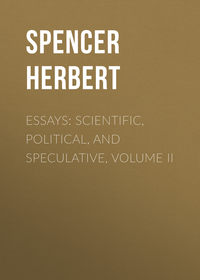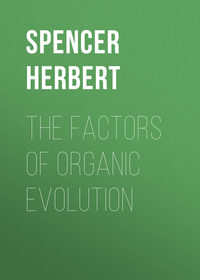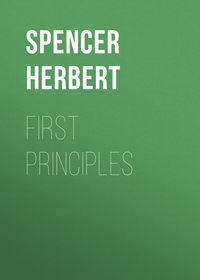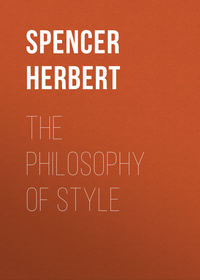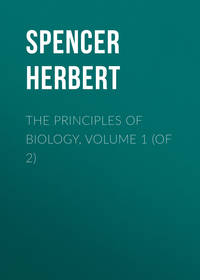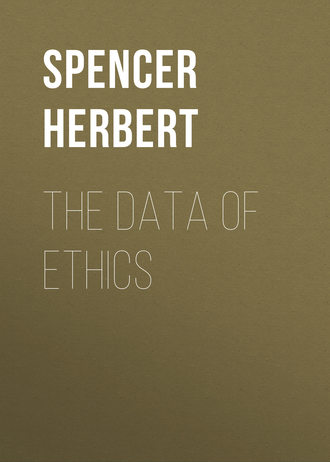 полная версия
полная версияThe Data of Ethics
This habit of contemplating only the psychical face of conduct, is so confirmed that an effort is required to contemplate only the physical face. Undeniable as it is that another's behavior to us is made up of movements of his body and limbs, of his facial muscles, and of his vocal apparatus, it yet seems paradoxical to say that these are the only elements of conduct really known by us, while the elements of conduct which we exclusively think of as constituting it, are not known but inferred.
Here, however, ignoring for the time being the inferred elements in conduct, we have to deal with the perceived elements – we have to observe its traits considered as a set of combined motions. Taking the evolution point of view, and remembering that while an aggregate evolves, not only the matter composing it, but also the motion of that matter, passes from an indefinite incoherent homogeneity to a definite coherent heterogeneity, we have now to ask whether conduct as it rises to its higher forms, displays in increasing degrees these characters; and whether it does not display them in the greatest degree when it reaches that highest form which we call moral.
§ 25. It will be convenient to deal first with the trait of increasing coherence. The conduct of lowly-organized creatures is broadly contrasted with the conduct of highly-organized creatures in having its successive portions feebly connected. The random movements which animalcule makes have severally no reference to movements made a moment before; nor do they affect in specific ways the movements made immediately after. To-day's wanderings of a fish in search of food, though perhaps showing by their adjustments to catching different kinds of prey at different hours, a slightly-determined order, are unrelated to the wanderings of yesterday and to-morrow. But such more developed creatures as birds, show us in the building of nests, the sitting on eggs, the rearing of chicks, and the aiding of them after they fly, sets of motions which form a dependent series, extending over a considerable period. And on observing the complexity of the acts performed in fetching and fixing the fibres of the nest or in catching and bringing to the young each portion of food, we discover in the combined motions, lateral cohesion as well as longitudinal cohesion.
Man, even in his lowest state, displays in his conduct far more coherent combinations of motions. By the elaborate manipulations gone through in making weapons that are to serve for the chase next year, or in building canoes and wigwams for permanent uses – by acts of aggression and defense which are connected with injuries long since received or committed, the savage exhibits an aggregate of motions which, in some of its parts, holds together over great periods. Moreover, if we consider the many movements implied by the transactions of each day, in the wood, on the water, in the camp, in the family, we see that this coherent aggregate of movements is composed of many minor aggregates that are severally coherent within themselves and with one another.
In civilized man this trait of developed conduct becomes more conspicuous still. Be his business what it may, its processes involve relatively numerous dependent motions; and day by day it is so carried on as to show connections between present motions and motions long gone by, as well as motions anticipated in the distant future. Besides the many doings, related to one another, which the farmer goes through in looking after his cattle, directing his laborers, keeping an eye on his dairy, buying his implements, selling his produce, etc., the business of getting his lease involves numerous combined movements on which the movements of subsequent years depend; and in manuring his fields with a view to larger returns, or putting down drains with the like motive, he is performing acts which are parts of a coherent combination relatively extensive. That the like holds of the shopkeeper, manufacturer, banker, is manifest; and this increased coherence of conduct among the civilized will strike us even more when we remember how its parts are often continued in a connected arrangement through life, for the purpose of making a fortune, founding a family, gaining a seat in Parliament.
Now mark that a greater coherence among its component motions broadly distinguishes the conduct we call moral from the conduct we call immoral. The application of the word dissolute to the last, and of the word self-restrained to the first, implies this – implies that conduct of the lower kind, constituted of disorderly acts, has its parts relatively loose in their relations with one another; while conduct of the higher kind, habitually following a fixed order, so gains a characteristic unity and coherence. In proportion as the conduct is what we call moral, it exhibits comparatively settled connections between antecedents and consequents; for the doing right implies that under given conditions the combined motions constituting conduct will follow in a way that can be specified. Contrariwise, in the conduct of one whose principles are not high, the sequences of motions are doubtful. He may pay the money or he may not; he may keep his appointment or he may fail; he may tell the truth or he may lie. The words trustworthiness and untrustworthiness, as used to characterize the two respectively, sufficiently imply that the actions of the one can be foreknown while those of the other cannot; and this implies that the successive movements composing the one bear more constant relations to one another than do those composing the other – are more coherent.
§ 26. Indefiniteness accompanies incoherence in conduct that is little evolved; and throughout the ascending stages of evolving conduct there is an increasingly definite co-ordination of the motions constituting it.
Such changes of form as the rudest protozoa show us, are utterly vague – admit of no precise description; and though in higher kinds the movements of the parts are more definable, yet the movement of the whole in respect of direction is indeterminate: there is no adjustment of it to this or the other point in space. In such cœlenterate animals as polypes we see the parts moving in ways which lack precision; and in one of the locomotive forms, as a medusa, the course taken, otherwise at random, can be described only as one which carries it toward the light, where degrees of light and darkness are present. Among annulose creatures the contrast between the track of a worm, turning this way or that at hazard, and the definite course taken by a bee in its flight from flower to flower or back to the hive, shows us the same thing; the bee's acts in building cells and feeding larvæ further exhibiting precision in the simultaneous movements as well as in the successive movements. Though the motions made by a fish in pursuing its prey have considerable definiteness, yet they are of a simple kind, and are in this respect contrasted with the many definite motions of body, head, and limbs gone through by a carnivorous mammal in the course of waylaying, running down, and seizing a herbivore; and further, the fish shows us none of those definitely adjusted sets of motions which in the mammal subserve the rearing of young.
Much greater definiteness, if not in the combined movements forming single acts, still in the adjustments of many combined acts to various purposes, characterizes human conduct, even in its lowest stages. In making and using weapons and in the maneuverings of savage warfare, numerous movements, all precise in their adaptations to proximate ends, are arranged for the achievement of remote ends, with a precision not paralleled among lower creatures. The lives of civilized men exhibit this trait far more conspicuously. Each industrial art exemplifies the effects of movements which are severally definite; and which are definitely arranged in simultaneous and successive order. Business transactions of every kind are characterized by exact relations between the sets of motions constituting acts, and the purposes fulfilled, in time, place, and quantity. Further, the daily routine of each person shows us in its periods and amounts of activity, of rest, of relaxation, a measured arrangement which is not shown us by the doings of the wandering savage, who has no fixed times for hunting, sleeping, feeding, or any one kind of action.
Moral conduct differs from immoral conduct in the same manner and in a like degree. The conscientious man is exact in all his transactions. He supplies a precise weight for a specified sum; he gives a definite quality in fulfillment of understanding; he pays the full amount he bargained to do. In times as well as in quantities, his acts answer completely to anticipations. If he has made a business contract he is to the day; if an appointment he is to the minute. Similarly in respect of truth: his statements correspond accurately with the facts. It is thus too in his family life. He maintains marital relations that are definite in contrast with the relations that result from breach of the marriage contract; and as a father, fitting his behavior with care to the nature of each child and to the occasion; he avoids the too much and the too little of praise or blame, reward or penalty. Nor is it otherwise in his miscellaneous acts. To say that he deals equitably with those he employs, whether they behave well or ill, is to say that he adjusts his acts to their deserts; and to say that he is judicious in his charities, is to say that he portions out his aid with discrimination instead of distributing it indiscriminately to good and bad, as do those who have no adequate sense of their social responsibilities.
That progress toward rectitude of conduct is progress toward duly-proportioned conduct, and that duly-proportioned conduct is relatively definite, we may see from another point of view. One of the traits of conduct we call immoral, is excess; while moderation habitually characterizes moral conduct. Now excesses imply extreme divergences of actions from some medium, while maintenance of the medium is implied by moderation; whence it follows that actions of the last kind can be defined more nearly than those of the first. Clearly conduct which, being unrestrained, runs into great and incalculable oscillations, therein differs from restrained conduct of which, by implication, the oscillations fall within narrower limits. And falling within narrower limits necessitates relative definiteness of movements.
§ 27. That throughout the ascending forms of life, along with increasing heterogeneity of structure and function, there goes increasing heterogeneity of conduct – increasing diversity in the sets of external motions and combined sets of such motions – needs not be shown in detail. Nor need it be shown that becoming relatively great in the motions constituting the conduct of the uncivilized man, this heterogeneity has become still greater in those which the civilized man goes through. We may pass at once to that further degree of the like contrast which we see on ascending from the conduct of the immoral to that of the moral.
Instead of recognizing this contrast, most readers will be inclined to identify a moral life with a life little varied in its activities. But here we come upon a defect in the current conception of morality. This comparative uniformity in the aggregate of motions, which goes along with morality as commonly conceived, is not only not moral but is the reverse of moral. The better a man fulfills every requirement of life, alike as regards his own body and mind, as regards the bodies and minds of those dependent on him, and as regards the bodies and minds of his fellow-citizens, the more varied do his activities become. The more fully he does all these things, the more heterogeneous must be his movements.
One who satisfies personal needs only, goes through other things equal, less multiform processes than one who also administers to the needs of wife and children. Supposing there are no other differences, the addition of family relations necessarily renders the actions of the man who fulfills the duties of husband and parent, more heterogeneous than those of the man who has no such duties to fulfill, or, having them, does not fulfill them; and to say that his actions are more heterogeneous is to say that there is a greater heterogeneity in the combined motions he goes through. The like holds of social obligations. These, in proportion as a citizen duly performs them, complicate his movements considerably. If he is helpful to inferiors dependent on him, if he takes a part in political agitation, if he aids in diffusing knowledge, he, in each of these ways, adds to his kinds of activity – makes his sets of movements more multiform; so differing from the man who is the slave of one desire or group of desires.
Though it is unusual to consider as having a moral aspect, those activities which culture involves, yet to the few who hold that due exercise of all the higher faculties, intellectual and æsthetic, must be included in the conception of complete life, here identified with the ideally moral life, it will be manifest that a further heterogeneity is implied by them. For each of such activities, constituted by that play of these faculties which is eventually added to their life-subserving uses, adds to the multiformity of the aggregated motions.
Briefly, then, if the conduct is the best possible on every occasion, it follows that as the occasions are endlessly varied the acts will be endlessly varied to suit – the heterogeneity in the combinations of motions will be extreme.
§ 28. Evolution in conduct considered under its moral aspect, is, like all other evolution, toward equilibrium. I do not mean that it is toward the equilibrium reached at death, though this is, of course, the final state which the evolution of the highest man has in common with all lower evolution; but I mean that it is toward a moving equilibrium.
We have seen that maintaining life, expressed in physical terms, is maintaining a balanced combination of internal actions in face of external forces tending to overthrow it; and we have seen that advance toward a higher life, has been an acquirement of ability to maintain the balance for a longer period, by the successive additions of organic appliances which by their actions counteract, more and more fully, the disturbing forces. Here, then, we are led to the conclusion that the life called moral is one in which this maintenance of the moving equilibrium reaches completeness, or approaches most nearly to completeness.
This truth is clearly disclosed on observing how those physiological rhythms which vaguely show themselves when organization begins, become more regular, as well as more various in their kinds, as organization advances. Periodicity is but feebly marked in the actions, inner and outer, of the rudest types. Where life is low there is passive dependence on the accidents of the environment; and this entails great irregularities in the vital processes. The taking in of food by a polype is at intervals now short, now very long, as circumstances determine; and the utilization of it is by a slow dispersion of the absorbed part through the tissues, aided only by the irregular movements of the creature's body; while, such æration as is effected is similarly without a trace of rhythm. Much higher up we still find very imperfect periodicities; as in the inferior molluscs which, though possessed of vascular systems, have no proper circulation, but merely a slow movement of the crude blood, now in one direction through the vessels and then, after a pause, in the opposite direction. Only with well-developed structures do there come a rhythmical pulse and a rhythm of the respiratory actions. And then in birds and mammals, along with great rapidity and regularity in these essential rhythms, and along with a consequently great vital activity and therefore great expenditure, comparative regularity in the rhythm of the alimentary actions is established, as well as in the rhythm of activity and rest; since the rapid waste to which rapid pulsation and respiration are instrumental, necessitates tolerably regular supplies of nutriment, as well as recurring intervals of sleep during which repair may overtake waste. And from these stages the moving equilibrium characterized by such interdependent rhythms, is continually made better by the counteracting of more and more of those actions which tend to perturb it.
So is it as we ascend from savage to civilized and from the lowest among the civilized to the highest. The rhythm of external actions required to maintain the rhythm of internal actions becomes at once more complicated and more complete, making them into a better moving equilibrium. The irregularities which their conditions of existence entail on primitive men, continually cause wide deviations from the mean state of the moving equilibrium – wide oscillations; which imply imperfection of it for the time being, and bring about its premature overthrow. In such civilized men as we call ill conducted, frequent perturbations of the moving equilibrium are caused by those excesses characterizing a career in which the periodicities are much broken; and a common result is that the rhythm of the internal actions being often deranged, the moving equilibrium, rendered by so much imperfect, is generally shortened in duration. While one in whom the internal rhythms are best maintained is one by whom the external actions required to fulfill all needs and duties, severally performed on the recurring occasions, conduce to a moving equilibrium that is at once involved and prolonged.
Of course the implication is that the man who thus reaches the limit of evolution, exists in a society congruous with his nature, is a man among men similarly constituted, who are severally in harmony with that social environment which they have formed. This is, indeed, the only possibility. For the production of the highest type of man can go on only pari passu with the production of the highest type of society. The implied conditions are those before described as accompanying the most evolved conduct – conditions under which each can fulfill all his needs and rear the due number of progeny, not only without hindering others from doing the like, but while aiding them in doing the like. And evidently, considered under its physical aspect, the conduct of the individual so constituted, and associated with like individuals, is one in which all the actions, that is the combined motions of all kinds, have become such as duly to meet every daily process, every ordinary occurrence, and every contingency in his environment. Complete life in a complete society is but another name for complete equilibrium between the co-ordinated activities of each social unit and those of the aggregate of units.
§ 29. Even to readers of preceding volumes, and still more to other readers, there will seem a strangeness, or even an absurdity, in this presentation of moral conduct in physical terms. It has been needful to make it, however. If that re-distribution of matter and motion constituting evolution goes on in all aggregates, its laws must be fulfilled in the most developed being as in every other thing; and his actions, when decomposed into motions, must exemplify its laws. This we find that they do. There is an entire correspondence between moral evolution and evolution as physically defined.
Conduct, as actually known to us in perception, and not as interpreted into the accompanying feelings and ideas, consists of combined motions. On ascending through the various grades of animate creatures, we find these combined motions characterized by increasing coherence, increasing definiteness considered singly and in their co-ordinated groups, and increasing heterogeneity; and in advancing from lower to higher types of man, as well as in advancing from the less moral to the more moral type of man, these traits of evolving conduct become more marked still. Further, we see that the increasing coherence, definiteness, and heterogeneity, of the combined motions, are instrumental to the better maintenance of a moving equilibrium. Where the evolution is small this is very imperfect and soon cut short; with advancing evolution, bringing greater power and intelligence, it becomes more steady and longer continued in face of adverse actions; in the human race at large it is comparatively regular and enduring; and its regularity and enduringness are greatest in the highest.
CHAPTER VI.
THE BIOLOGICAL VIEW
§ 30. The truth that the ideally moral man is one in whom the moving equilibrium is perfect, or approaches nearest to perfection, becomes, when translated into physiological language, the truth that he is one in whom the functions of all kinds are duly fulfilled. Each function has some relation, direct or indirect, to the needs of life: the fact of its existence as a result of evolution, being itself a proof that it has been entailed, immediately or remotely, by the adjustment of inner actions to outer actions. Consequently, non-fulfillment of it in normal proportion is non-fulfillment of a requisite to complete life. If there is defective discharge of the function, the organism experiences some detrimental result caused by the inadequacy. If the discharge is in excess, there is entailed a reaction upon the other functions, which in some way diminishes their efficiencies.
It is true that during full vigor, while the momentum of the organic actions is great, the disorder caused by moderate excess or defect of any one function, soon disappears – the balance is re-established. But it is none the less true that always some disorder results from excess or defect, that it influences every function, bodily and mental, and that it constitutes a lowering of the life for the time being.
Beyond the temporary falling short of complete life implied by undue or inadequate discharge of a function there is entailed, as an ultimate result, decreased length of life. If some function is habitually performed in excess of the requirement, or in defect of the requirement; and if, as a consequence, there is an often repeated perturbation of the functions at large, there results some chronic derangement in the balance of the functions. Necessarily reacting on the structures, and registering in them its accumulated effects, this derangement works a general deterioration; and when the vital energies begin to decline, the moving equilibrium, further from perfection than it would else have been, is sooner overthrown: death is more or less premature.
Hence the moral man is one whose functions – many and varied in their kinds, as we have seen – are all discharged in degrees duly adjusted to the conditions of existence.
§ 31. Strange as the conclusion looks, it is nevertheless a conclusion to be here drawn, that the performance of every function is, in a sense, a moral obligation.
It is usually thought that morality requires us only to restrain such vital activities as, in our present state, are often pushed to excess, or such as conflict with average welfare, special or general; but it also requires us to carry on these vital activities up to their normal limits. All the animal functions, in common with all the higher functions, have, as thus understood, their imperativeness. While recognizing the fact that in our state of transition, characterized by very imperfect adaptation of constitution of conditions, moral obligations of supreme kinds often necessitate conduct which is physically injurious; we must also recognize the fact that, considered apart from other effects, it is immoral so to treat the body as in any way to diminish the fullness or vigor of its vitality.
Hence results one test of actions. There may in every case be put the questions – Does the action tend to maintenance of complete life for the time being? and does it tend to prolongation of life to its full extent? To answer yes or no to either of these questions, is implicitly to class the action as right or wrong in respect of its immediate bearings, whatever it may be in respect of its remote bearings.
The seeming paradoxicalness of this statement results from the tendency, so difficult of avoidance, to judge a conclusion which presupposes an ideal humanity, by its applicability to humanity as now existing. The foregoing conclusion refers to that highest conduct in which, as we have seen, the evolution of conduct terminates – that conduct in which the making of all adjustments of acts to ends subserving complete individual life, together with all those subserving maintenance of offspring and preparation of them for maturity, not only consist with the making of like adjustments by others, but furthers it. And this conception of conduct in its ultimate form implies the conception of a nature having such conduct for its spontaneous outcome – the product of its normal activities. So understanding the matter, it becomes manifest that under such conditions any falling short of function, as well as any excess of function, implies deviation from the best conduct or from perfectly moral conduct.


